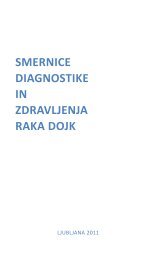Create successful ePaper yourself
Turn your PDF publications into a flip-book with our unique Google optimized e-Paper software.
Correlation of chromosomal abnormalities and results<br />
of microsatellite markers analysis in radiation induced<br />
T-cell lymphomas in mice<br />
J. Piskorowska 1 , H. Szymanska 1 , E. Krysiak 1 , M. Gajewska 1 ,<br />
B. Pienkowska-Grela 3 , H. Skurzak 2 , P. Demant 4 , A. Czarnomska 1<br />
1<br />
Department of Genetics and Laboratory Animal Breeding, The Maria Sklodowska -<br />
Curie Memorial Cancer Center and Institute of Oncology, Warsaw, Poland; 2 Department<br />
of Immunology, The Maria Sklodowska - Curie Memorial Cancer Center and Institute<br />
of Oncology, Warsaw, Poland; 3 Cytogenetic Laboratory, The Maria Sklodowska - Curie<br />
Memorial Cancer Center and Institute of Oncology, Warsaw, Poland; 4 Department of<br />
Cellular and Molecular Biology, Roswell Park Cancer Institute, Buffalo, N.Y., U.S.A.<br />
The aim of the presented investigations was to map the genes responsible for the<br />
development of radiation induced T-cell lymphoma in recombinant congenic mouse<br />
strains (RCS) CcS/Dem. The tumors were histopathologically and immunologically<br />
classified. Morphology of mouse lymphomas was evaluated by microscopic<br />
examination. Estimating the phenotype of lymphomas was based on flow cytometry<br />
(FCM) analysis. The lymphomas were classified according to “Bethesda proposals<br />
for classification of lymphoid neoplasms in mice” (20<strong>02</strong>).<br />
In order to map the genes responsible for radiation-induced T-cell lymphomas the<br />
neoplasms representing two from seven found immunophenotypes were selected:<br />
CD90 + (CD4/CD8) + sCD3 + and CD90 + (CD4/CD8) + sCD3 - . The microsatellite analysis<br />
was performed using the PCR amplification method. Genomic DNA was obtained<br />
from the tail of mice. DNA of all animals with tumor was characterized for the 24<br />
microsatellite loci. The PCR amplification was performed as described by Dietrich<br />
et al.(1992).<br />
The genetic linkage has been evaluated using the SAS package, and the significance<br />
of the observed linkages has been corrected for whole genome screening as<br />
described by Lander and Kruglyak (1996). The obtained results suggested linkage of<br />
the genes responsible for radiation-induced T-cell lymphomas in CcS mice involving<br />
chromosomes 10 (D10 Mit134) and 16 (D16 Mit34).<br />
Cytogenetic analysis of these tumors was performed according to the standard<br />
procedure. G-bands were obtained with Wright stain. The karyotypes were described<br />
according to the International Committee on Standardized Genetic Nomenclature for<br />
Mice: Rules for nomenclature of chromosome aberrations (2005) and documented<br />
with the Lucia imaging system. The analysis of the found non random chromosome<br />
abnormalities - translocations and metacentric translocations - seems to confirm the<br />
results obtained by microsatellite investigations.<br />
p34107

















